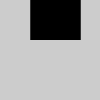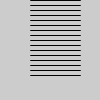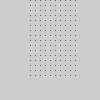| Name | for |
||||||
|---|---|---|---|---|---|---|---|
| Examples |

for i in range(40):
line(30, i, 80, i)

for i in range(0, 80, 5):
line(30, i, 80, i)

for i in range(40, 80, 5):
line(30, i, 80, i)

# Nested for() loops can be used to
# generate two-dimensional patterns
for i in range(30, 80, 5):
for j in range(0, 80, 5):
point(i, j)

nums = [5, 4, 3, 2, 1]
for i in nums:
print(i)
| ||||||
| Description |
Controls a sequence of repetitions. In Python, a for loop requires a list function to iterate over. The range() function provides such a list, and accepts arguments in three ways: range(10) # Creates the list [0, 1, 2, 3, 4, 5, 6, 7, 8, 9] range(5, 10) # Creates the list [5, 6, 7, 8, 9] range(5, 10, 2) # Creates the list [5, 7, 9] In the first example above, the for structure is executed 40 times. The for structure loops until it reaches the last element of the list created by range(40): 39. A second type of for structure makes it easier to iterate over each element of a list. The last example above shows how it works. First, define a variable name. This variable name will be assigned to each element of the list in turn as the for moves through the entire list. Then specify the list to iterate over after in, in this case nums. |
||||||
| Syntax |
for var in iterable:
statements
for var in iterable:
statements
| ||||||
| Parameters |
| ||||||
| Related |
while |
Updated on Tue Feb 27 14:07:12 2024.
If you see any errors or have comments, please let us know.

This work is licensed under a Creative Commons Attribution-NonCommercial-ShareAlike 4.0 International License